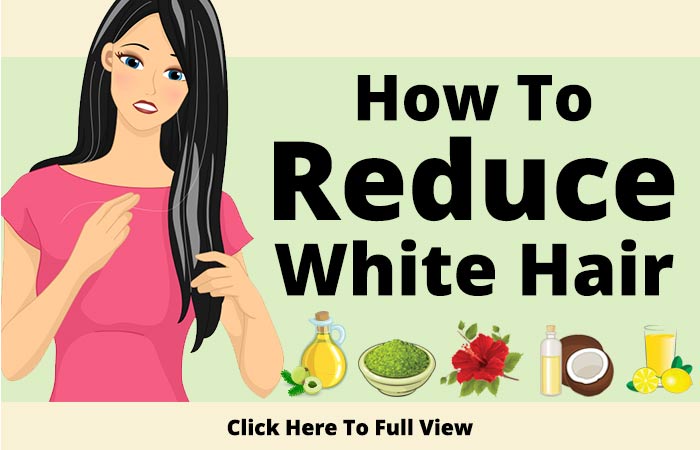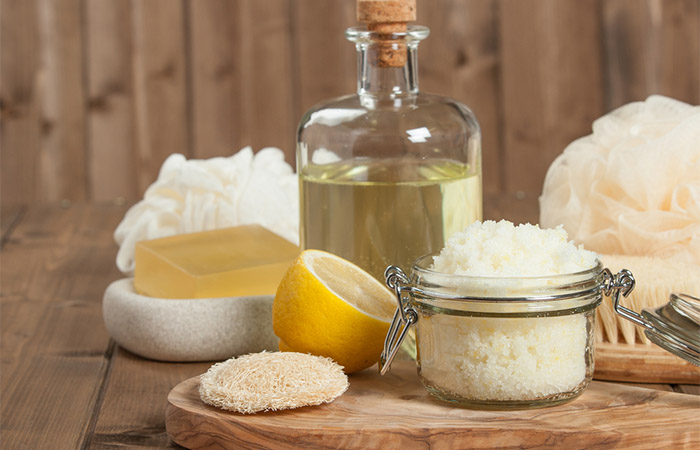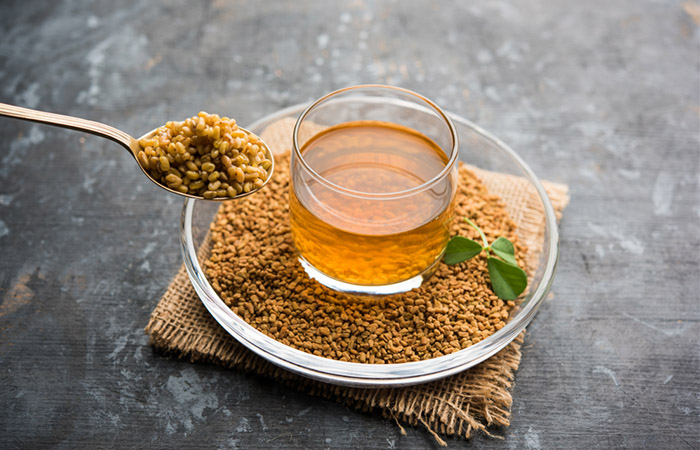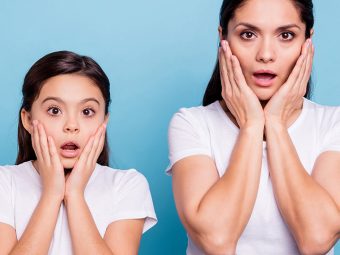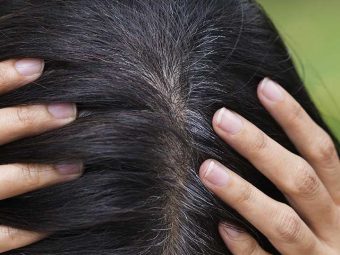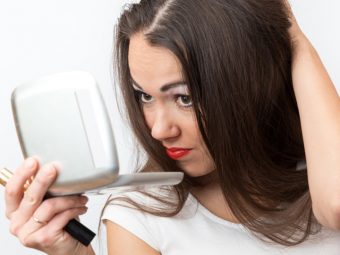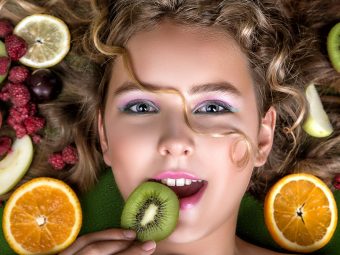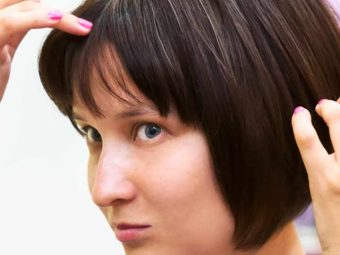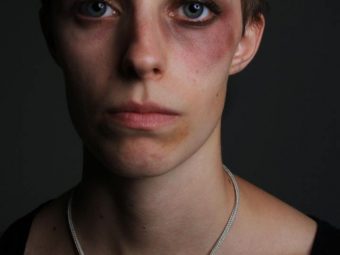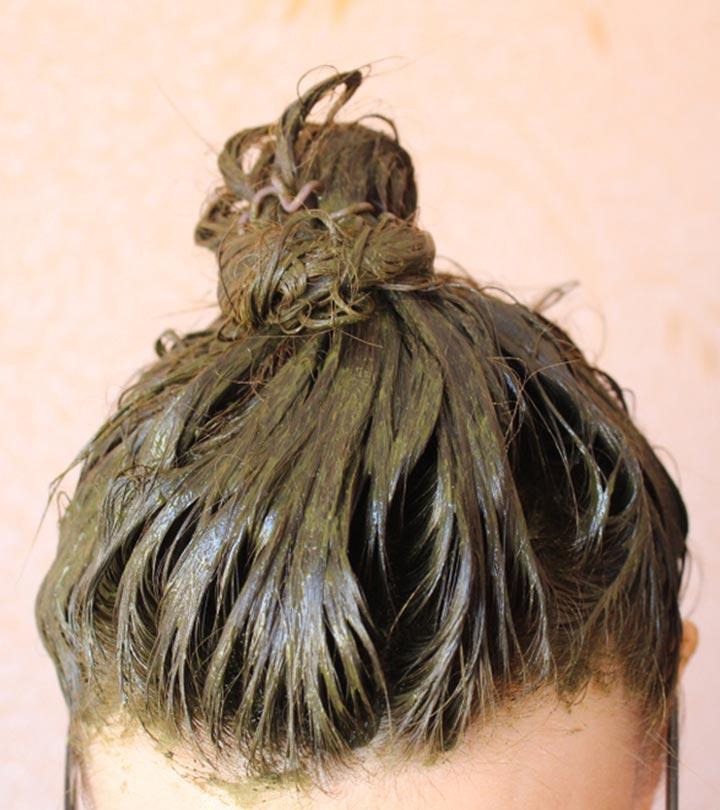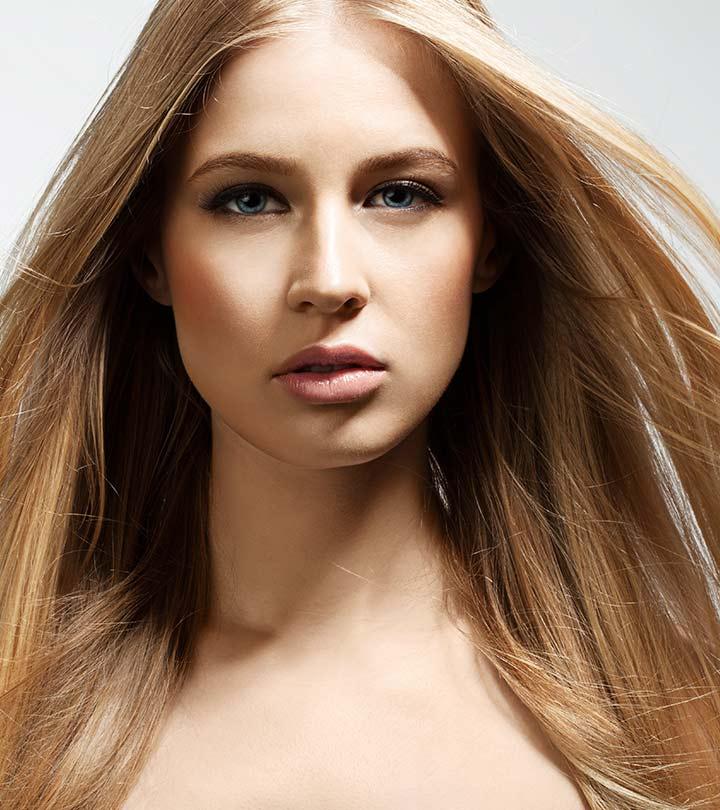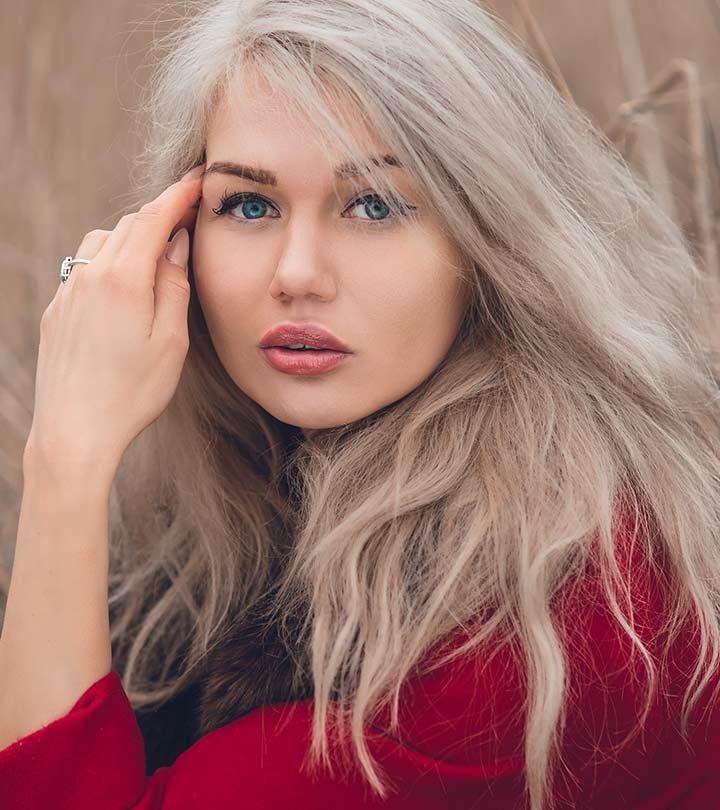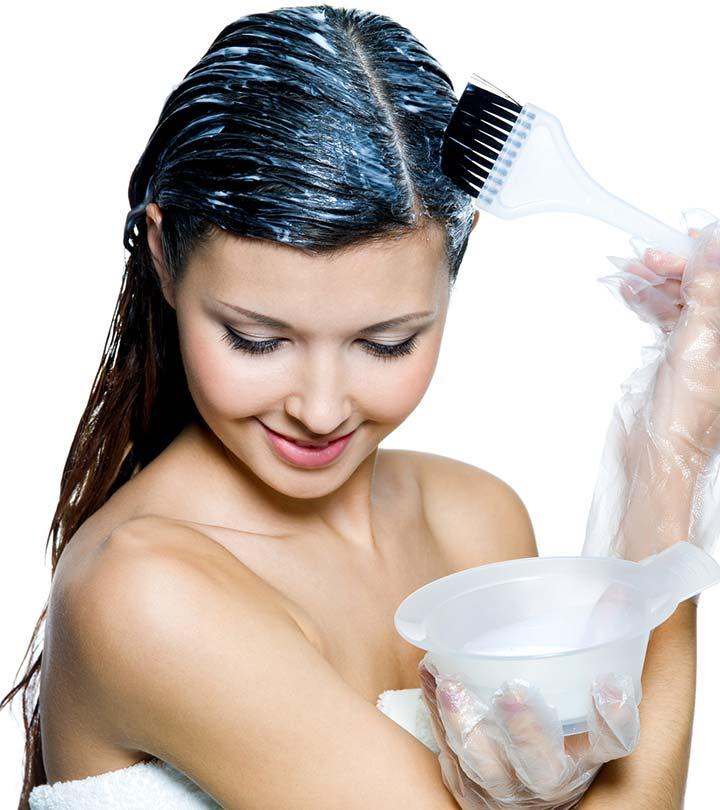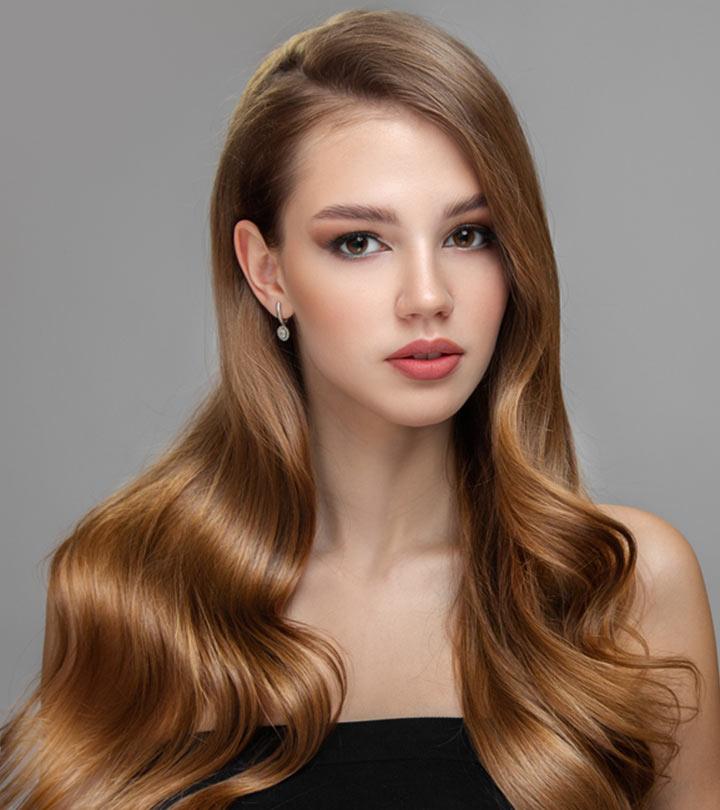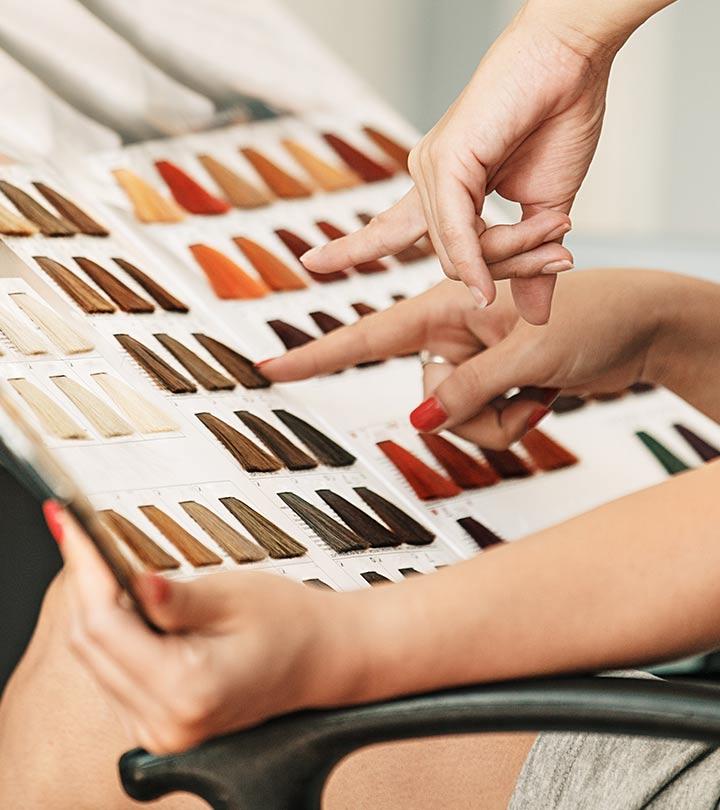10 Causes Of White Hair And 13 Ways To Prevent It Naturally
Avoid premature hair graying with the help of simple remedies and precautions.
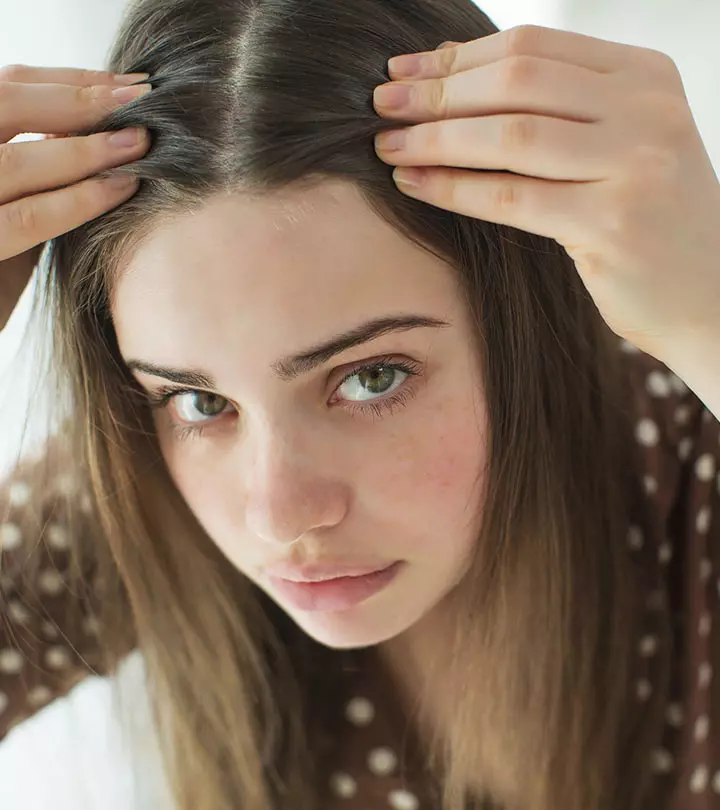
Image: ShutterStock
White hair is one of the most perplexing side effects of modern living, and nothing compares to the terror you feel when your first white strand appears. You know there will be many more, so you hunt for cures and therapies to help you avoid the obvious. So, learn how you can get rid of white hair right here.
White hair is linked with the aging process. However, it is depressing to detect it in your mid-thirties or early twenties. White and gray hair are the consequence of loss of hair pigments. Gray hair occurs when the hair pigment is significantly reduced. It becomes completely white when there is no pigment available. Unfortunately, the root cause of why hair becomes white is still unknown. If you are looking for a solution to your white hair problem, in this article, we have listed a few options for preventing white hair growth. Keep reading.
In This Article
What Causes White Hair?
Hair growth happens when old cells are pushed out by the hair follicles due to the production of new cells. It occurs in three stages – growth (anagen), cessation (catagen), and rest (telogen). During the rest period, your hair reaches its lifespan and falls out, and a new strand grows in its place. Hair color is produced by hair melanin, which is formed by melanocytes. Hair pigmentation, unlike in skin, is not continuous. The hair is actively pigmented in the anagen phase. Pigmentation reduces in the catagen phase and is absent in the telogen phase (1).
Casey Simmons, a curly hair expert, says, “Hair can change in color and shape as you age due to changes in skin cells and hormones.” She also adds, “Other health factors like thyroid issues, lack of iron, iodine, and vitamin B12 may also cause hair to gray.”
With age, the amount of pigment that is injected into each strand of hair gets reduced, which is why it turns gray and eventually white. In the section below, let’s discuss common white hair causes and how to prevent white hair.
Early-onset of gray hair occurs due to the following factors:
1. Genes
Dr. K. Harish Kumar, MD, DVL, says, “Genes are the predominant factor in determining at what age your hair loses pigment.” For some people, it can happen even before they turn 20. For others, the first strands of white appear rather late (1).
A blogger using the pseudonym Pepper, who candidly shares her day-to-day experiences, opens up about her white strands, expressing frustration at people’s reactions. She shares, “It really sucks that my mother-in-law does not have a single strand of grey at 58, whereas I, despite being under 30 have a million. People tend to compare and I feel like smacking them and telling them I didn’t get my genes from my in-laws. I got them from my parents. My mother has been suffering from premature greying from the time she was a teen (i)”.
2. Deficiency Of Melanin
In most of the cases, a deficiency of melanin is the leading cause of hair whitening. The production of melanin depends on appropriate hair nutrition and protein supplements. The lack of these nutrients causes melanin to fall below acceptable levels (2).
3. Hormones
Research suggests that an imbalance in hormones can trigger or increase premature graying of hair (1), (3). If you have excess graying of hair and aren’t sure if you have a hormonal imbalance, please consult a doctor.
4. Medical Conditions
Certain underlying medical conditions can trigger a loss of pigment in your hair. PGH is also triggered by autoimmunei XA condition where the body’s immune system mistakes healthy cells for foreign cells and attacks its own body. diseases like vitiligoi XA disease where one’s skin, especially that around the mouth or eyes, loses its color in patches due to a lack of melanin pigment. , pernicious anemia, thyroid diseases, and premature aging syndromes (4).
 Trivia
Trivia5. Vitamin And Mineral Deficiency
Deficiency in iron, vitamin D, folate, vitamin B12, and selenium may also cause the whitening of hair follicles. Deficiencies of Vitamin B12 and folic acid with lower levels of biotin were found in people having premature graying of hair (5).
6. Stress
Emotional stress also plays a role here. Studies have shown that the oxidative load caused by psychological stress can trigger premature graying of hair (1).
7. Chemicals
Sometimes, the use of chemical-based shampoos, soaps, hair dyes, etc. may directly cause this problem. However, it can result from some allergic infections as well.
8. Oxidative Stress
Oxidative stress can cause premature graying. It is caused due to an overproduction of oxidants in the body, which are also affected by extrinsic factors like ultraviolet (UV) rays, pollution, emotional factors, or inflammatory causes (2).
9. Smoking
Studies have shown that smoking is one of the major factors leading to premature graying of hair. Smoking causes reactive oxygen species damage to hair follicle melanocytes, which leads to premature graying (1).
10. Hydrogen Peroxide
The hair follicles produce small amounts of hydrogen peroxide, which gets accumulated overtime on the hair shafts. It bleaches the hair and causes it to turn gray, and eventually white (6). Removing this build-up may help your hair regain its natural color.
Can You Get Rid Of White Hair?
Whether or not hair graying can be reversed to help white hair turn black largely depends on the cause of graying. If genetics are responsible, there is not much one can do to reverse the change.
If the cause is an underlying health problem, consulting a doctor to see what can be done is the best course of action. Once the problem is treated, it may help restore pigment to your hair. However, this cannot be guaranteed.
Re-pigmentation is sometimes possible after hormone therapy treatment. Another way to promote pigmentation is by taking shots or pills of vitamin B12. You can also try the natural remedies mentioned below and know how to reduce white hair.
Natural Remedies To Reduce White (Gray) Hair
1. Indian Gooseberry And Coconut Oil
Indian gooseberry (amla) has a rich reserve of vitamin C, which is an antioxidant and has anti-aging benefits and revitalizes the pigment in your hair follicles (7). Coconut oil penetrates through the hair shaft and reduces protein loss. This improves hair health (8). Thus, coconut hair oil massage proves very effective.
You Will Need
- 3-5 Indian gooseberries
- 1 cup of coconut oil
Process
- Boil 3-4 Indian gooseberries with one cup of coconut oil to prepare an oil solution.
- Store this oil in a jar and take about two tablespoons for each use.
- Massage the oil into your scalp and work it through the length of your hair.
- After massaging for about 15 minutes, leave the oil on for an additional 30 minutes. Alternatively, you can leave the oil in overnight.
- Wash off with a mild sulfate-free shampoo and finish with conditioner.
How Often?
2-4 times a week.
2. Black Tea
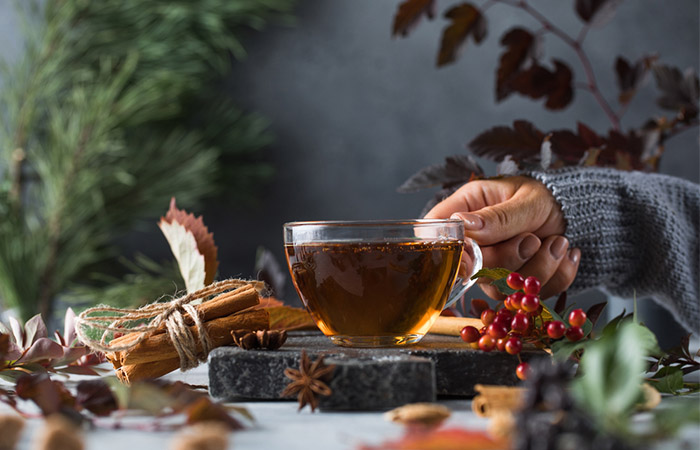
Black tea is rich in antioxidants (9). These antioxidants can help prevent free radical damage to hair, and thus, premature graying. It also helps darken hair color while adding shine. Black tea is also known to help relieve stress (10). As discussed, stress is a contributing factor to the premature graying of hair.
You Will Need
- 2 tablespoons of black tea
- 1 cup of water
Process
- Boil two tablespoons of black tea in a cup of water until it is well brewed.
- Set the brew aside to cool.
- Strain the liquid and apply it to your hair and scalp.
- Massage your scalp for a couple of minutes and wait for about an hour with the tea in your hair.
- Wash your hair with a mild sulfate-free shampoo and finish with conditioner.
How Often?
2-3 times a week.
3. Curry Leaves And Coconut Oil
Curry leaves are popularly used to retain and maintain natural hair tone and prevent premature graying of hair (11). Coconut oil can penetrate the hair follicles to nourish the hair right from the root and promote hair growth (8).
You Will Need
- A handful of curry leaves
- 3 tablespoons of coconut oil
Process
- Boil a handful of curry leaves with 3 tablespoons of coconut oil to prepare an oil solution.
- Set the oil aside to cool.
- Once it has cooled, strain the oil and massage it into your scalp and work it through the length of your hair.
- After massaging for about 15 minutes, leave the oil on for an additional 30 minutes. Alternatively, you can leave the oil in overnight.
- Wash off with a mild sulfate-free shampoo and finish with conditioner.
How Often?
2-3 times a week.
4. Lemon Juice And Coconut Oil
Lemon contains vitamin C, an antioxidant that can neutralize free radicals and prevent hair damage (12). However, there is no scientific evidence to prove that lemon juice can reverse the graying of hair. Coconut oil nourishes your hair and promotes hair growth (8).
You Will Need
- 2 teaspoons of lemon juice
- 2 tablespoons of coconut oil
Process
- Pour two teaspoons of lemon juice into two tablespoons of coconut oil and heat the mixture for a couple of seconds until it is slightly warm.
- Massage this mixture into your scalp and work it down to the tips of your hair.
- Leave it on for about 30 minutes.
- Wash your hair with a mild sulfate-free shampoo and finish with conditioner.
How Often?
2 times a week.
5. Castor Oil With Coconut Oil
Castor oil boosts blood circulation to the follicles. It contains omega-6 essential fatty acids that promote hair health and hair darkening (13).
You Will Need
- 1 tablespoon of castor oil
- 2 tablespoons of coconut oil
Process
- Combine one tablespoon of castor oil with two tablespoons of coconut oil and heat the blend for a couple of minutes until it is slightly warm.
- Massage this oil mixture onto your scalp and work it down to the tips of your hair.
- After massaging your scalp for about 15 minutes, leave it on for an additional 30 minutes.
- Wash your hair with a mild sulfate-free shampoo and finish with conditioner.
How Often?
2-3 times a week.
6. Fenugreek Seeds
Fenugreek is rich in B vitamins and saponins that prevent hair loss (14). It is popularly used to preserve the natural hair color, prevent dandruff, and keep the hair silky (15).
You Will Need
- 2 tablespoons of fenugreek seeds
- 1/4 cup of water
Process
- Soak two tablespoons of fenugreek seeds in a quarter cup of water overnight.
- In the morning, grind the seeds with enough water to get a smooth, consistent paste.
- Apply this mixture to your hair and scalp and leave it on for about 45 minutes.
- Wash your hair with a mild sulfate-free shampoo and finish with conditioner.
How Often?
1-2 times a week.
7. Onion Juice And Olive Oil
A study indicated that onion juice might help reduce hair fall and aid hair regrowth in a few people (16). Onion juice also contains catalase that can help reduce hydrogen peroxide build-up on your hair and scalp, thus helping reverse graying and improving the health of your hair. However, the only drawback to using this remedy is that it is hard to get the onion smell out of your hair. Olive oil is an emollient and conditions your hair (17).
You Will Need
- 1 medium-sized onion
- t tablespoon of olive oil
- A cheesecloth
Process
- Chop a medium-sized onion into small pieces and blend it with about a tablespoon of olive oil.
- Squeeze the juice out of the pulp using a cheesecloth.
- Apply this juice onto your scalp and massage for about 10 minutes.
- Leave the juice on for an additional 30-35 minutes.
- Wash your hair with a mild sulfate-free shampoo and condition.
How Often?
2 times a week.
8. Henna And Coffee
Henna helps cover up the appearance of white hair by adding rich reddish tones to your hair due to the presence of lawsone (18). Coffee is another popular hair colorant that can impart a reddish-brown to blackish-brown tinge to your hair.
Note: Ensure that you are using pure henna powder as some powders contain chemicals.
You Will Need
- 5 tablespoons of henna powder
- 1 tablespoon of coffee
- 1 cup of water
Process
- Brew one tablespoon of coffee in a cup of water.
- Add five tablespoons of henna powder to the brew, stirring as you do to avoid lumps.
- Apply this mixture to your scalp and hair and leave it on for about 3-4 hours.
- Rinse with warm water and a mild sulfate-free shampoo.
How Often?
Once every three weeks.
9. Sage Leaves
Sage leaves help in preserving the color of your hair and prevent graying. In some cases, they also help restore pigment to white hair patches (17).
You Will Need
- A handful of sage leaves
- Water
- Spray bottle
Process
- Boil a handful of sage leaves in water until it is well brewed.
- Let the concoction cool and then collect the liquid in a spray bottle.
- Spritz your hair until all of your hair is saturated with the sage tea.
- Leave the tea on for about 2 hours.
- Wash the sage solution out of your hair with a mild shampoo and finish with conditioner.
How Often?
2-3 times a week.
 Quick Tip
Quick Tip10. Ridge Gourd And Coconut Oil
Ridge gourd can help restore natural hair pigment and prevent premature graying of hair (19). Coconut oil penetrates the hair shaft and nourishes your hair (8).
You Will Need
- 1/2 cup of chopped and dried ridge gourd
- 1 cup of coconut oil
Process
- Soak half a cup of chopped and dried ridge gourd in a cup of coconut oil in an airtight jar for about 3-4 days.
- After 4 days, take about two tablespoons of the oil and heat it until it is slightly warm.
- Massage the oil into your scalp and then work it down to the tips of your hair.
- After massaging your hair for about 15 minutes, leave the oil on for an additional 30 minutes.
- Wash your hair with a mild sulfate-free shampoo and finish with conditioner.
How Often?
2-3 times a week.
11. Sesame Seed Oil And Coconut Oil
Coconut oil is one of the most penetrative hair oils with a rich source of fatty acids that help condition your hair (8). In combination with sesame seed oil, it helps promote melanocyte activity, ensuring that each strand is deeply pigmented. Sesame seed oil also helps darken the color of your hair with regular use (17).
You Will Need
- 2 tablespoons sesame seed oil
- 2 tablespoons coconut oil
- Hot towel
Process
- Combine two tablespoons each of sesame seed oil and coconut oil and heat the mixture until it is slightly warm.
- Apply the oil onto your scalp and then work it through the length of your hair.
- After massaging for about 15 minutes, cover your hair with a hot towel, and leave the oil in for an additional 30 minutes.
- Wash your hair with a mild sulfate-free shampoo and finish with conditioner.
How Often?
2-3 times a week.
12. Indian Gooseberry And Hibiscus Flower
This mask may help in hair follicles stimulation, strengthening and nourishing your hair. It may help maintain scalp health and boost healthy hair growth. Hibiscus may help prevent premature graying being a hair conditioning technique, making it manageable (17).
You Will Need
- 3 tablespoons of crushed hibiscus leaves and flowers
- 3 tablespoons of amla powder
- Water
Process
- Blend the hibiscus paste with amla powder to get a smooth paste. You can add a little water to the mixture to ensure that the paste is smooth and consistent.
- Apply the mixture to your scalp and work it down to the tips of your hair.
- Leave the mask on for about 45 minutes.
- Wash your hair with a mild sulfate-free shampoo and finish with conditioner.
How Often?
2 times a week.
13. Ashwagandha
Anecdotal evidence suggests that ashwagandha may stimulate melanin production owing to its tyrosine (an amino acid one needs to make proteins) content. Restoration of lost melanin (the substance responsible for pigmentation of hair and skin) could potentially reverse premature hair graying (1).
You Will Need
- 2-3 tablespoons ashwagandha powder
- 2-3 tablespoons coconut or almond oil
Process
- Mix ashwagandha powder with coconut or almond oil to make a paste.
- Apply the paste on your scalp and hair.
- Gently massage it into your scalp.
- Leave it on for 30-45 minutes.
- Wash it off with a mild shampoo.
How Often?
2-3 times a week
In addition to following the remedies listed above, you can also follow these tips to reduce gray hair.
Tips For Reducing Gray Hair
1. Increase Intake Of Vitamin B12
Your hair could be turning white due to a deficiency of vitamin B12 (5). If this is the case, reversing the graying process could be as simple as consuming sufficient amounts of the vitamin.
Vitamin B12 deficiency causes pernicious anemiai XA condition where the body cannot absorb enough vitamin B12 due to a decrease in red blood cells, leading to fatigue and weakness. , and your hair losing its pigment is a symptom of the condition. This condition can be reversed by maintaining a balanced diet that is giving you the right amounts of the vitamin.
2. Increase Intake of Vitamin B5
Vitamin B5 is known to help prevent the early onset of graying hair and restore its natural color (20). It also aids hair growth, gives hair proper moisture, and has anti-inflammatory properties.
Consume foods rich in vitamin B5 like mushrooms, beef liver, eggs, whole grains, broccoli, sunflower seeds, etc. (21).
3. Keep The Thyroid Levels In Check
Your thyroid gland has an impact on all the vital functions of your body. An underactive thyroid, or hypothyroidism, can result in premature white hair (3). It is necessary to monitor your thyroid levels to be aware if it is causing the loss of pigment in your hair.
Hypothyroidism is a serious chronic condition and might require hormone supplementation. Certain foods can interfere with the working of your thyroid gland. To keep your thyroid levels in check, keep tabs on your diet.
4. Quit Smoking
Your lifestyle has a huge influence on the health and color of your hair. Smoking has adverse effects on your body and could be contributing to white hair (1). A study determined that smokers have a higher chance of their hair losing pigment than non-smokers (22).
5. Load Up On Antioxidants
Your diet may help prevent the occurrence of white hair. Make sure that you consume enough antioxidant-rich foods.
6. Protect Your Hair From UV Rays
One of the extrinsic factors of oxidative stress is UV rays, which lead to premature graying of hair. Make sure you protect your hair when going out in the sun with a scarf or hat. There are a number of heat protection products that protect hair follicles from the harmful sun rays.
7. Foods To Eat To Reduce White Hair
If you are graying due to a vitamin B12 deficiency, you should consume more seafood, eggs, and meat, including pork, beef, and lamb. Dairy products, such as milk and cheese, are good sources as well. Those following a vegetarian or vegan diet can opt for supplements or products that are enriched with vitamin B12 after consulting their doctor.
Also, consume antioxidant-rich foods such as berries, grapes, green leafy vegetables, and green tea.
Here’s a list of foods that can help aid hair growth and delay premature graying of hair (20):
- Berries – They are rich in vitamin C.
- Meat liver – Combats anemia and iron deficiencies.
- Carrots – Rich in vitamin A.
- Curry leaves – Rich in the B vitamins and minerals such as selenium, iodine, zinc, and iron.
- Spinach – Helps in the production of melanin.
- Eggs – Rich in vitamin B12.
- Beans – Rich source of protein.
- Sunflower seeds – Rich in antioxidants and minerals.
- Walnuts – Rich source of copper, which helps in melanin production.
According to a study published in the journal BMC Genomics, 14.3% of people between the ages of 18 and 30 were found to have gray hair. Young males (17.8%) were found to have significantly more gray hair than young females (9.2%). The 2020 study was conducted on Polish individuals of and above the age of 18 years.
Can White Hair Turn Black Again?
Casey Simmons says, “The skin cell’s melanin is not known to typically have come back and increased in production, as they are naturally reducing from age and change in hormones.”
A 2016 mice study targeted molecular pathways that control hair pigmentation to restore color. The mice exhibited growth of melanocytes that form melanin in the skin and hair. The discovery suggested that developing a drug or other therapy to target these pathways may help bring back some color to gray tresses (23).
With the right diagnosis and customized white hair treatment, graying can be reversed, and white hair can turn black. But if the problem is genetic or age-related, it is unlikely to reverse the process. It is possible, however, to slow it down with a balanced diet and a good hair care regimen.
Infographic: How To Prevent Gray Hair At An Early Stage
Gray hair has now become a prevalent issue. Unfortunately, even young children have a few white hairs, which can be distressing and unsettling. The infographic below lists a few recommendations for preventing white hair at a young age. Discover more by scrolling down.

Illustration: StyleCraze Design Team
Our hair turns gray with age. Though gray hair is mostly associated with aging, you can also get white hair in your early 20s or 30s due to the loss of hair pigments. Though you cannot completely reverse the graying of hair, you can try a few home remedies and make diet and lifestyle changes to prevent further graying and slow down the process. The remedies mentioned above may help you know how to get rid of white hair. These hair oil treatments may help in hair root nourishment and hair root strengthening. Ayurvedic treatments and herbal treatments are also there for hair toning. However, you may have to be patient to see the results.
Frequently Asked Questions
Can exercise prevent white hair?
Casey Simmons, curly hair expert, says, “In theory, exercise promotes the overall health of the body, and, therefore, hair. However, it has not been scientifically proven to prevent gray hair. The main factor in hair going gray is a reduction in melanin, which has not been known to be affected by exercise.”
Should I pluck white hair?
You should never pluck your white or graying hair. Plucking out the hair causes trauma to the hair follicles, and repeated trauma may cause permanent damage. It may affect new hair growth and its texture and lead to infections, scars, or even bald patches.
Which fruit is good for preventing white hair?
The Indian gooseberry, also known as Amla, may promote pigmentation and reduce graying. Gooseberry is rich in antioxidants and has anti-aging properties. It is also used in many hair care products.
Is white hair normal at 22?
A few gray hair strands are normal during the early and late 20s. However, premature graying may indicate underlying conditions like nutrient deficiencies, hormonal imbalances, and other medical conditions.
What causes white hair at an early age?
Various factors like genes, environmental damage, oxidative stress, and vitamin and mineral deficiencies can be the cause of white hair at a young age. Young people with vitiligo may also develop white hair patches on the affected scalp area.
Why do I have white hair at 15?
The reason for white hair at 15 could possibly be due to a gene inherited from the parents or grandparents. It could also be a deficiency of Vitamins B-6, B-12, D, E, or biotin. Several environmental factors or stress can also break down the pigments in hair shafts, leading to white hair.
Key Takeaways
- Premature graying can be brought on by exposure to chemicals and pollution. Stress and trauma are also responsible for this.
- The appearance of white hair can be diminished by eating a nutritious, well-balanced nutritional diet that is high in vitamins and minerals.
- You can also take hair vitamin and hair mineral supplements.
- It can be avoided by reducing stress through exercise, meditation, and adequate sleep.
- Hair health can be maintained with the use of mild, chemical-free hair care products. This also helps with graying.
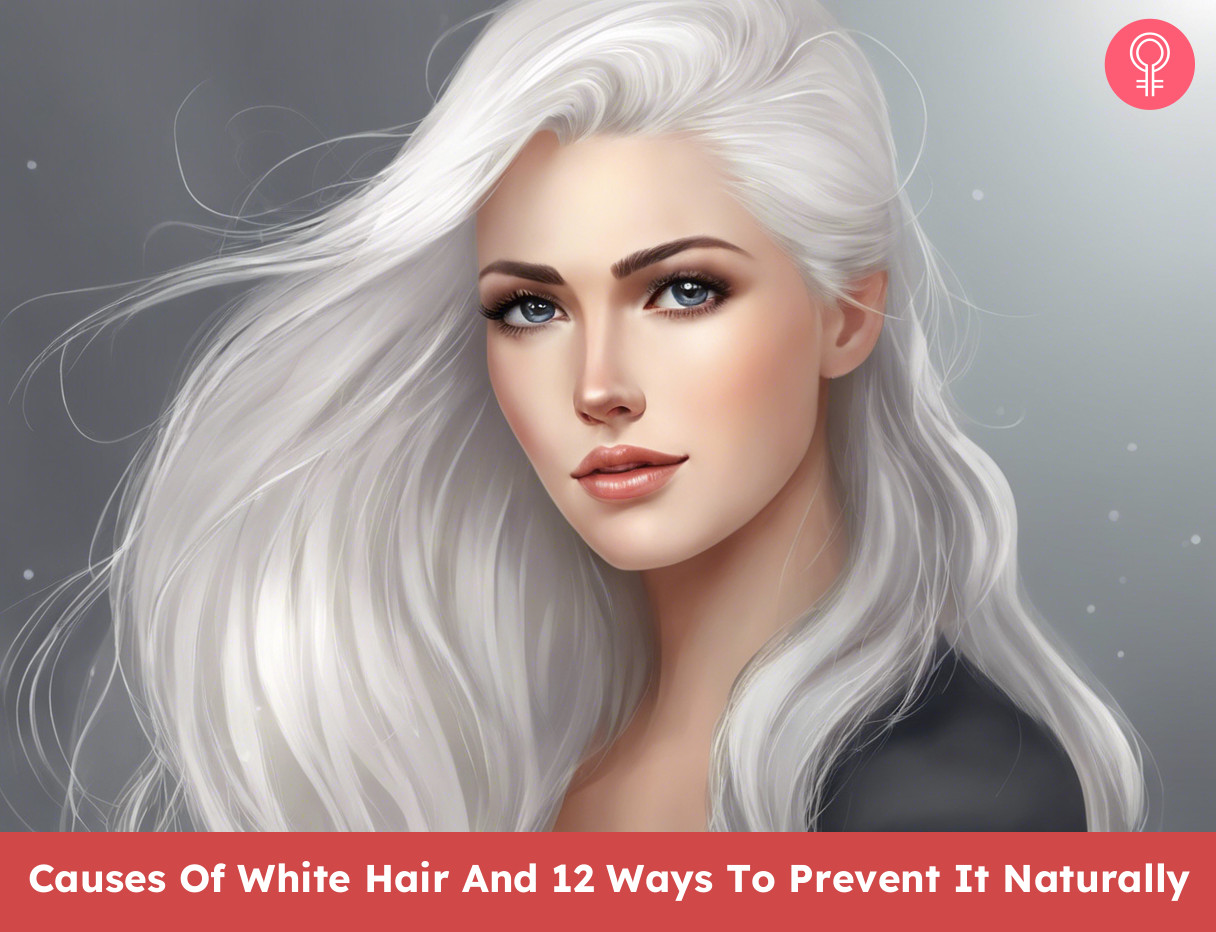
Image: Stable Diffusion/StyleCraze Design Team
Transform white hair to black naturally and permanently with clove. Say goodbye to gray hair in just 3 weeks. Watch the video and rejuvenate your hair color.
Personal Experience: Source
StyleCraze's articles are interwoven with authentic personal narratives that provide depth and resonance to our content. Below are the sources of the personal accounts referenced in this article.
i. My very own 50 shades of greyhttps://pepperedthoughts.wordpress.com/2015/08/26/my-very-own-50-shades-of-grey/
References
Articles on StyleCraze are backed by verified information from peer-reviewed and academic research papers, reputed organizations, research institutions, and medical associations to ensure accuracy and relevance. Read our editorial policy to learn more.
- Premature Graying of Hair: Review with Updates, International Journal of Trichology, US National Library of Medicine, National Institutes of Health.
https://www.ncbi.nlm.nih.gov/pmc/articles/PMC6290285/ - Oxidative Stress in Ageing of Hair, International Journal of Trichology, US National Library of Medicine, National Institutes of Health.
https://www.ncbi.nlm.nih.gov/pmc/articles/PMC2929555/ - Three Streams for the Mechanism of Hair Graying, Annals of Dermatology, US National Library of Medicine, National Institutes of Health.
https://www.ncbi.nlm.nih.gov/pmc/articles/PMC6029974/ - Epidemiological and Investigative Study of Premature Graying of Hair in Higher Secondary and Pre-University School Children, International Journal of Trichology, US National Library of Medicine, National Institutes of Health.
https://www.ncbi.nlm.nih.gov/pmc/articles/PMC3746220/ - The Role of Vitamins and Minerals in Hair Loss: A Review, Dermatology and Therapy, US National Library of Medicine, National Institutes of Health.
https://www.ncbi.nlm.nih.gov/pmc/articles/PMC6380979/ - Senile hair graying: H2O2-mediated oxidative stress affects human hair color by blunting methionine sulfoxide repair, The FASEB Journal.
https://onlinelibrary.wiley.com/doi/full/10.1096/fj.08-125435 - Preclinical and Clinical Studies Demonstrate That the Proprietary Herbal Extract DA-5512 Effectively Stimulates Hair Growth and Promotes Hair Health, Evidence-based Complementary and Alternative Medicine, US National Library of Medicine, National Institutes of Health.
https://www.ncbi.nlm.nih.gov/pmc/articles/PMC5429933/ - Effect of mineral oil, sunflower oil, and coconut oil on prevention of hair damage. Journal of Cosmetic Science, US National Library of Medicine, National Institutes of Health.
https://www.ncbi.nlm.nih.gov/pubmed/12715094/ - Antioxidative properties of black tea. Preventive Medicine, US National Library of Medicine, National Institutes of Health.
https://www.ncbi.nlm.nih.gov/pubmed/15850895 - The effects of tea on psychophysiological stress responsivity and post-stress recovery: a randomised double-blind trial. Psychopharmacology, US National Library of Medicine, National Institutes of Health.
https://www.ncbi.nlm.nih.gov/pubmed/17013636 - Murraya koenigii (L.) (Curry Leaf): A Traditional Indian Plant. Research Journal of Pharmaceutical, Biological and Chemical Sciences.
https://www.rjpbcs.com/pdf/2015_6(6)/%5B118%5D.pdf - Vitamin C in dermatology, Indian Dermatology Online Journal, US National Library of Medicine, National Institutes of Health.
https://www.ncbi.nlm.nih.gov/pmc/articles/PMC3673383/ - Castor Oil Plant (Ricinus communis L.): A Potential Oil Crop for Agribusiness in Africa, International Journal of Applied Research and Technology, ResearchGate.
https://www.researchgate.net/publication/317497913_Castor_Oil_Plant_Ricinus_communis_L_A_Potential_Oil_Crop_for_Agribusiness_in_Africa - A Systematic Review on Hair Care and Herbs Used in Hair Fall Treatment, International Journal of Ayurveda and Pharmaceutical Chemistry.
https://oaji.net/articles/2017/1791-1538241010.pdf - A study of phytochemical constituents and pharmacological actions of Trigonella foenum-graecum: A review, International Journal of Pharmacy and Technology, ResearchGate.
https://www.researchgate.net/publication/215552453_A_study_of_phytochemical_constituents_and_pharmacological_actions_of_Trigonella_foenum-graecum_A_review - Onion juice (Allium cepa L.), a new topical treatment for alopecia areata. The Journal of Dermatology, US National Library of Medicine, National Institutes of Health.
https://www.ncbi.nlm.nih.gov/pubmed/12126069 - Ethnopharmacological survey of home remedies used for treatment of hair and scalp and their methods of preparation in the West Bank-Palestine, BMC Complementary and Alternative Medicine, US National Library of Medicine, National Institutes of Health.
https://www.ncbi.nlm.nih.gov/pmc/articles/PMC5499037/ - Synthesis and Evaluation of Herbal Based Hair Dye, The Open Dermatology Journal, ResearchGate.
https://www.researchgate.net/publication/328388284_Synthesis_and_Evaluation_of_Herbal_Based_Hair_Dye - Therapeutic Potential of Luffa acutangula: A Review on Its Traditional Uses, Phytochemistry, Pharmacology and Toxicological Aspects, Frontiers in Pharmacology, US National Library of Medicine, National Institutes of Health.
https://www.ncbi.nlm.nih.gov/pmc/articles/PMC6232903/ - Nutrition of women with hair loss problem during the period of menopause, Menopause Review, US National Library of Medicine, National Institutes of Health.
https://www.ncbi.nlm.nih.gov/pmc/articles/PMC4828511/ - Pantothenic Acid, Office of Dietary Supplements, National Institutes of Health.
https://ods.od.nih.gov/factsheets/PantothenicAcid-HealthProfessional/ - Smokers’ hair: Does smoking cause premature hair graying? Indian Dermatology Online Journal, US National Library of Medicine, National Institutes of Health.
https://www.ncbi.nlm.nih.gov/pmc/articles/PMC3673399/ - EdnrB Governs Regenerative Response of Melanocyte Stem Cells by Crosstalk with Wnt Signaling, Cell Reports, US National Library of Medicine, National Institutes of Health.
https://www.ncbi.nlm.nih.gov/pmc/articles/PMC5391032/





